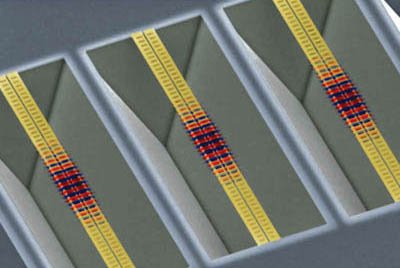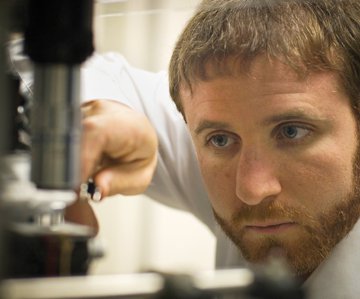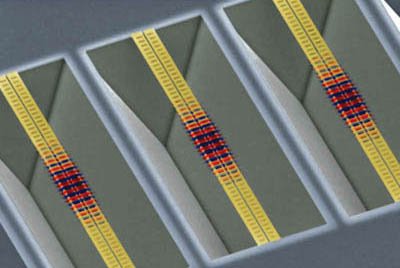Producing coherent light on a microchip is old hat—LED lasers underpin our high-tech world, appearing in gadgets ranging from DVD players and supermarket checkout scanners to digital data lines. Now a chip-compatible component developed in the laboratory of Caltech Associate Professor of Applied Physics Oskar Painter (MS '95, PhD '01) can produce coherent sound as well, and even interconvert the two.
"What is new here is the ability to manipulate sound in a circuit with the same level of control, and in almost the same way, that we manipulate light or electrons," says collaborator Kerry Vahala (BS '80, MS '81, PhD '85), the Jenkins Professor of Information Science and Technology and professor of applied physics. "It helps to level the playing field for these three different particles—electrons, photons, and phonons."
This light-to-sound and sound-to-light translator, known in the trade as an optomechanical crystal, looks like the rope bridge in an Indiana Jones movie. The bridge traps photons of light and phonons—with an "n"—of sound in the gaps between its floorboards, causing the energy to resonate and accumulate in the acoustic equivalent of a laser. And, like a laser, a beam of sonic energy can carry information.

With this technology, engineers will be able to design circuits to manipulate sound in almost the same way that we now use light or electrons, switching from one to another as best suits the application. For example, inserting so-called acoustical delays into fiber-optic systems will vastly increase the number of channels that can be sent through the same hardware.
The technology will also find use as a new tool for the physical sciences. Biolabs on a chip could measure subtle changes in a bridge's vibrations to detect and identify individual protein molecules. And the bridges are so insubstantial that they can behave quantum mechanically, allowing physicists to manipulate a nanoscale object that is literally neither here nor there. Farther down the road, this window on the mechanical quantum world could provide the input-output interface to quantum computers, which would exploit such quantum weirdnesses to solve problems uncrackable by ordinary machines.

Eventually, sonic "lasers" are likely to change our lives in ways we can't begin to imagine. Says postdoc Matthew Eichenfield (PhD '10), "When Charles Townes [PhD '39; Nobel laureate in physics, 1964] invented the maser, which eventually gave birth to the laser, he didn't envision CDs, or supermarket checkout scanners, or using them to write your name on the diamond in an engagement ring. We're in the ruby-laser era with these. In a few years, we'll be putting out phonons on a level with commercial lasers."
"This field of research is blossoming at Caltech," says Painter, "because we have a number of groups bringing together expertise in areas as diverse as nanofabrication and quantum optics. I think the next few years are going to be tremendously productive. I find it fascinating that we can work in areas that touch upon fundamental quantum physics and at the same time have a real impact on engineering and technology."
 Grad student Matt Eichenfield aligns a microchip with the optical fiber at the test station.
Grad student Matt Eichenfield aligns a microchip with the optical fiber at the test station.
 The photon trap looks like a rope bridge in an Indiana Jones movie. Photons can only run along the bridge for as long as the floorboards match their stride--that is, their wavelength. Light leaks from the thin, gray optical taper in the background into the bridge, and there it gets stuck.
The photon trap looks like a rope bridge in an Indiana Jones movie. Photons can only run along the bridge for as long as the floorboards match their stride--that is, their wavelength. Light leaks from the thin, gray optical taper in the background into the bridge, and there it gets stuck.
 Pairs of bridges span essentially bottomless pits on the microchip. Each bridge is about 30 millionths of a meter long and one millionth of a meter wide. The red and blue bands represent the trapped light.
Pairs of bridges span essentially bottomless pits on the microchip. Each bridge is about 30 millionths of a meter long and one millionth of a meter wide. The red and blue bands represent the trapped light.
